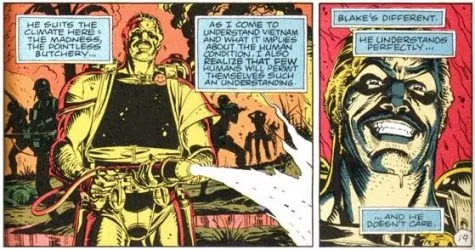Via non linear story telling, the story also examines the social and political implications of having superheroes in the real world, questioning the morality of vigilantism and exploring the idea of power and corruption.
One way in which "Watchmen" subverts superhero mythology is by questioning the idea of heroism itself. The main characters, known as the "Watchmen," are not the traditional archetypal heroes of comic books.
One way in which "Watchmen" subverts superhero mythology is by questioning the idea of heroism itself. The main characters, known as the "Watchmen," are not the traditional archetypal heroes of comic books.
They are morally ambiguous, often committing violent and questionable acts in the name of justice. For example, Rorschach, one of the main characters, is a vigilante who wears a mask with constantly shifting patterns and sees the world in black and white. He is willing to resort to extreme violence to achieve his goals, and ultimately becomes a villain in the eyes of the other characters.
Another way in which "Watchmen" subverts superhero mythology is by exploring the darker side of superpowers. The character of Dr. Manhattan, a former physicist who gains god-like powers after a laboratory accident, is initially portrayed as a benevolent and omnipotent figure. However, as the story progresses, it becomes clear that his god-like abilities have left him disconnected from humanity, and he becomes increasingly distant and dispassionate.
The use of graphic violence in "Watchmen" is also a departure from traditional superhero comics, where violence is often sanitized or depicted in a cartoonish manner. The violence in "Watchmen" is often brutal and realistic, with characters being depicted as bloodied and wounded after fights.
In addition, "Watchmen" is notable for its metafictional elements, with the narrative itself reflecting on the nature of storytelling and the comic book medium. The story includes a comic-within-a-comic called "Tales of the Black Freighter," which is read by one of the characters and serves as a parallel to the main story. This self-reflexivity adds another layer of complexity to the story and contributes to the overall deconstruction of the superhero genre.
Overall, the deconstruction of superhero mythology in "Watchmen" has had a significant impact on the comic book genre as a whole. The story's exploration of complex characters, realistic violence, and metafictional elements has influenced subsequent comic book works, and has helped to establish a new approach to superhero storytelling that is more grounded and nuanced.

Here are some additional points to consider in the deconstruction of superhero mythology in "Watchmen":
- Critique of American imperialism: "Watchmen" takes place in an alternate history where the United States won the Vietnam War, and explores the consequences of American imperialism. The character of the Comedian, a government-sanctioned superhero and war veteran, embodies the brutal and violent nature of American foreign policy. His actions in Vietnam, including the rape and murder of a civilian woman, highlight the destructive impact of American interventionism.
- Examination of the superhero's relationship with society: Unlike traditional superhero comics where the public adores and idolizes superheroes, "Watchmen" portrays a world where superheroes are treated with suspicion and hostility. The government has outlawed vigilantism, and many of the characters struggle with their place in society. The character of Silk Spectre II, for example, questions whether she has any agency or is simply a pawn in the schemes of the male characters.
- Subversion of the superhero's role in preserving law and order: While traditional superheroes uphold the law and protect the innocent, the superheroes in "Watchmen" are often the ones committing crimes and causing chaos. The villainous plan of the character Ozymandias to create a fake alien invasion to bring about world peace, for example, is a morally dubious solution that sacrifices innocent lives for the greater good.
- Deconstruction of the hero/villain dichotomy: "Watchmen" blurs the lines between hero and villain, and even the characters themselves are unsure of their moral standing. Rorschach, for example, is initially presented as a hero but ultimately becomes a ruthless vigilante, while Ozymandias is revealed to be the mastermind behind the plot to destroy New York City but justifies his actions as necessary for the greater good.
- Exploration of the psychological impact of being a superhero: "Watchmen" delves into the psychological toll that being a superhero can take on individuals. Many of the characters suffer from PTSD, addiction, and other mental health issues as a result of their experiences as superheroes. Nite Owl for example is jaded and cynical - questioning his place in the world.












